Menus
- New two-stroke sport enduros from KTM
- What counts is on the pitch
- The engine runs noticeably cleaner than before
- Injector hangs alive on the gas
- It will continue to exist in the future
- Interview with Joachim Sauer (Offroad Product Manager)
- Buy used KTM 250 EXC TPI and 300 EXC TPI

KTM
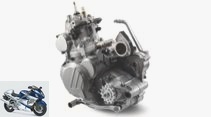
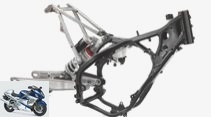
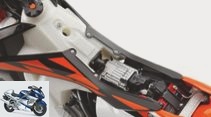

28 photos

KTM
1/28
KTM 250/300 EXC TPI in the driving report
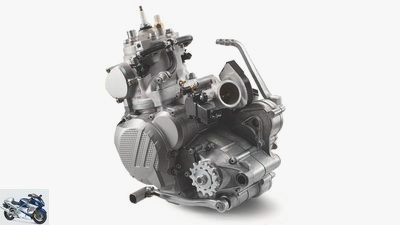
KTM
2/28
TPI – this is how it works: Only air flows through the throttle valve housing into the crankcase. The petrol is only injected into the two rear transfer ports. The air pressed through the front transfer ports pushes the exhaust gas out and thus reduces the loss of unburned fresh gas
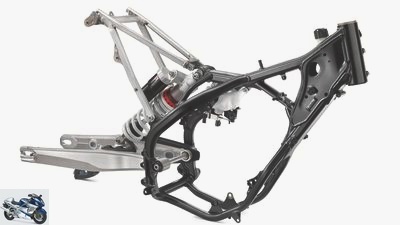
KTM
3/28
Stock: The 0.7 liter tank for the two-stroke oil (in front of the shock absorber) is filled behind the steering head
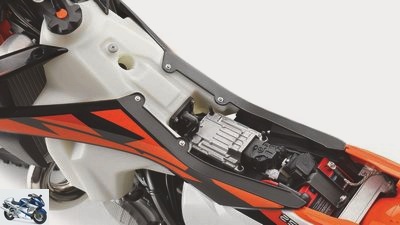
KTM
4/28
Knowing how: The central computer (silver) uses the data from five sensors to determine the injection quantity and ignition timing

KTM
5/28
KTM 250/300 EXC TPI in the driving report
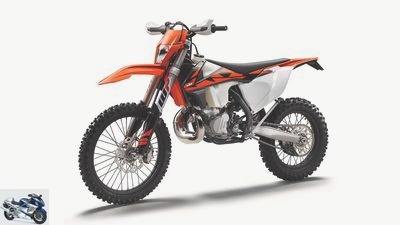
KTM
6/28
KTM 300 EXC TPI in the driving report

KTM
7/28
KTM 300 EXC TPI in the driving report
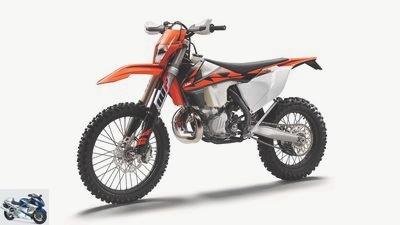
KTM
8/28
KTM 250 EXC TPI in the driving report
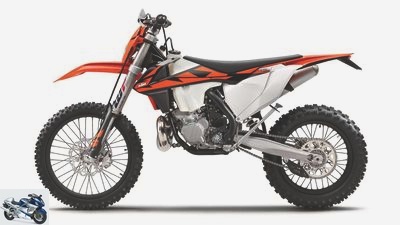
KTM
9/28
KTM 250 EXC TPI in the driving report

KTM
10/28
KTM 250/300 EXC TPI in the driving report

KTM
11/28
KTM 250/300 EXC TPI in the driving report

KTM
12/28
KTM 250/300 EXC TPI in the driving report

KTM
13/28
KTM 250/300 EXC TPI in the driving report

KTM
14/28
KTM 250/300 EXC TPI in the driving report

KTM
15/28
KTM 250/300 EXC TPI in the driving report
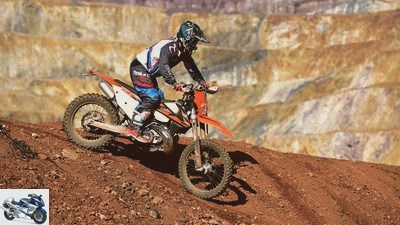
KTM
16/28
KTM 250/300 EXC TPI in the driving report

KTM
17/28
KTM 250/300 EXC TPI in the driving report

KTM
18/28
KTM 250/300 EXC TPI in the driving report

KTM
19/28
KTM 250/300 EXC TPI in the driving report

KTM
20/28
KTM 250/300 EXC TPI in the driving report

KTM
21/28
KTM 250/300 EXC TPI in the driving report

KTM
22/28
KTM 250/300 EXC TPI in the driving report

KTM
23/28
KTM 250/300 EXC TPI in the driving report
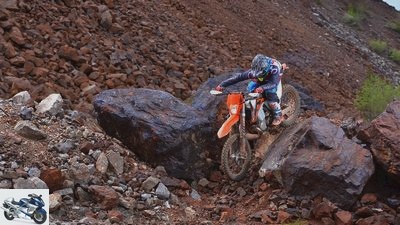
KTM
24/28
KTM 250/300 EXC TPI in the driving report

KTM
25/28
KTM 250/300 EXC TPI in the driving report

KTM
26/28
KTM 250/300 EXC TPI in the driving report

KTM
27/28
KTM 250/300 EXC TPI in the driving report

KTM
28/28
KTM 250/300 EXC TPI in the driving report
KTM 250 EXC TPI and KTM 300 EXC TPI in the driving report
New two-stroke sport enduros from KTM
In four-stroke engines, carburettors have long been out. With a new injection technology, KTM is now making two-stroke sport enduros fit for the future. The first ride with the new sports enduro bikes KTM 250 EXC TPI and KTM 300 EXC TPI.
The sword of Damocles of admission has long been hanging over sport enduro bikes. Off-road bikes have not been homologated at full power for decades. The Euro 4 standard has made the situation even worse. It pulls the noose even tighter, especially for the two-stroke engines, which are already critical in terms of exhaust emissions. TPI, Transfer Port Injection, is the name of the technology that KTM now uses for the two-stroke KTM 250 EXC and KTM 300 EXC would like to make future-proof. To do this, the carburetor is replaced by a throttle valve housing.
Buy complete article

KTM 250 EXC TPI and KTM 300 EXC TPI in the driving report
New two-stroke sport enduros from KTM
Conventional injection replaced
In contrast to conventional injection, in which the gasoline is injected into the throttle valve housing, the housing supplied by Dellorto only flows through air. As was previously the case with the mixture, it is pre-compressed in the crankcase and pressed in the direction of the combustion chamber via transfer ducts. This is where TPI comes in. In the air flowing upwards, gasoline is only injected into the two rear of the total of five transfer ducts (injection pressure: 3.5 bar). The reason: the burnt exhaust gas is only blown out with pure air via the three front transfer channels closer to the outlet. Unburned fresh gas – the reason for the problematic exhaust gas behavior in two-stroke engines – thus reaches the exhaust tract of the two sports enduro bikes KTM 250 EXC and KTM 300 EXC in smaller quantities.
What counts is on the pitch
Also new: For the first time, the two-stroke competition KTM 250 EXC and KTM 300 EXC are supplied with oil via separate lubrication. The two-stroke oil is stored in a 0.7 liter tank and injected through a nozzle behind the throttle valve. With this separate supply, the oil addition can be adapted to the load condition. The proportion of oil fluctuates between 1:60 (high load) and 1: 100 (low load), but always remains below the usual ratio of 1:50 for mixed lubrication. But now, no more explanations. What matters is on the pitch. Press on the button. What is different? Not much at first sight. After all, the engine housing, clutch and gearbox were largely adopted unchanged from the 2017 model.
The engine runs noticeably cleaner than before
In the background, five sensors collect data (pressure situation in the crankcase, air pressure, position of the throttle valve, water temperature, speed) and send it to the on-board computer. On the basis of this information, the black box calculates the ignition point and injection quantity. The two-stroke engine therefore normally no longer needs a choke. Only when it is very cold can a manual idle gas increase stabilize the idling speed during the warm-up phase. But it is precisely this that is already noticeable in the first few meters with a markedly low level of around 1,200 rpm. With the low load, the engine of the two sports enduro bikes, the KTM 250 EXC and KTM 300 EXC, runs noticeably cleaner than before, and – probably due to the lower oil surplus – depends more on the gas. A noticeable advantage on single trails or in trial-like passages.
Injector hangs alive on the gas
The differences disappear on faster terrain. The injector feels unchanged. Lively, he hangs on the gas and impresses with his slim figure – MOTORRAD weighed the 2017 KTM-300-EXC without petrol at just 102 kilos – and smooth running all along the line. Thanks to the injection, the differences between the two mappings that can be set on the handlebar switch are much more pronounced than with the carburetor models. Level one is deliberately gentle to work and is suitable for critical traction conditions. Level two responds more aggressively, but delivers more punch in the upper speed range. The differences between the 250 and 300 versions are also significantly greater than before. The easier running of the engine makes the KTM 250 EXC feel much lighter than its big sister.
It will continue to exist in the future
Subjectively, this corresponds roughly to the difference between a four-stroke and a two-stroke enduro. The consumption now also seems to be based on this. The fuel consumption during the presentation could not be quantified, but the savings of between 30 and 50 percent declared by KTM seem realistic. The only horse’s foot: with a very brisk stroke, the injector becomes lean, then looks pointed and less controllable. Is it a consequence of the shorter time available for swirling the mixture in the upper speed range? Might be. Nevertheless: the bottom line is that the two-stroke enduro bikes KTM 250 EXC and KTM 300 EXC with TPI technology gain in rideability, smoothness and environmental friendliness. And the most important thing: It will therefore continue to exist in the future.
Interview with Joachim Sauer (Offroad Product Manager)
Joachim Sauer (55), Offroad Product Manager at KTM, on the importance of the two-stroke engine in the market and the need to update two-stroke sports engines with injection.
MOTORCYCLE: How big is the share of two-stroke enduro models in global sales at KTM?
Joachim Sauer: KTM sold almost 40,000 competitive enduro bikes last year. About half of them are two-stroke models.
MOTORCYCLE: And how is the relationship in Germany?
Joachim Sauer: Similar. Also about fifty-fifty.
MOTORCYCLE: The technical effort for the TPI technology is considerable. Can the additional costs per motorcycle compared to the carburettor models be quantified??
Joachim Sauer: Not to the euro, of course. But there was no other choice. Without the new technology, our enduro two-stroke engines would have died. In this respect, we believe that the price increase of 450 euros for a KTM 250 or KTM 300 EXC TPI is justified.
MOTORCYCLE: With what power are the 250 or 300 EXC TPI models of the 2018 model year homologated?
Joachim Sauer: With around 14 hp.
MOTORCYCLE: The Euro 4 approval is therefore only possible with a greatly reduced and actually unrelated top performance. For the most part, customers will still have to travel illegally despite TPI technology.
Joachim Sauer: This problem does not only impose on us the exhaust gas behavior. The Euro 4 emission values could still be met even with more power. The noise regulations, which we cannot comply with without extreme insulation measures in the intake and exhaust areas, are critical.
MOTORCYCLE: If the limit values are tightened further, the final step towards direct injection in the two-stroke engine takes place?
Joachim Sauer: According to the current status, we also create the limit values for Euro 5 with TPI technology. That is why we are not currently developing a direct injection engine.
Buy used KTM 250 EXC TPI and 300 EXC TPI
1000PS marketplace app
The offer of all KTM EXC TPI in Germany.
At the time of this writing, the range of used KTM 250 EXC TPI and 300 EXC TPI is still relatively small. However, the KTM dealer network is good, which is why many examples are available as new vehicles. Here it goes to the motorcycle market: KTM 250 EXC TPI and 300 EXC TPI offers in Germany.
Related articles
-
Manufacturer 28 photos Manufacturer 1/28 The Honda CB 1100 was previously only available in Japan and Australia, but now Europe can also benefit from the…
-
Driving report Yamaha WR 250-450 F
Driving report Yamaha WR 250/450 F Full pack What is good for the crossers can’t hurt for the hard enduro bikes. That’s why MOTORRAD plowed through the…
-
Honda CBR 650 F in the HP driving report
Honda 18th photos Honda 1/18 Honda CBR 650 F in the HP driving report. Honda 2/18 Adults: The display makes a tidy impression, looks valuable and…
-
Beta sport enduro models of the 2017 model year in the driving report
beta 14th photos beta 1/14 Unusual: An Italian manufacturer of all people does not use Brembo brakes. But the retarders from Nissin are extremely easy to…
-
KTM Freeride 250 R in the driving report
Campelli 56 pictures 1/56 Campelli 2/56 Campelli 3/56 Campelli 4/56 Campelli 5/56 Campelli 6/56 Campelli 7/56 Campelli 8/56 Campelli 9/56 Campelli 10/56 …
-
Ducati Multistrada 1200 S in the driving report
Ducati 20 pictures Ducati 1/20 Ducati Multistrada 1200 S. Ducati 2/20 Ducati Multistrada 1200 S. Ducati 3/20 Ducati Multistrada 1200 S. Ducati 4/20 Ducati …
-
Ducati Multistrada 1200 Enduro in the driving report
Ducati 25 pictures Ducati 1/25 Let’s first see what the Duc offers: thick comfort seat, large suitcase (special equipment), high windshield …
-
Triumph Tiger Explorer XCA in the driving report
triumph 18th photos triumph 1/18 In terms of optics, the Triumph Tiger Explorer hasn’t changed much, … triumph 2/18 The off-road mode is the only one…
-
SWM Motorcycles 9 photos SWM Motorcycles 1/9 SWM SM 650 R model year 2016: 6,490 euros. SWM Motorcycles 2/9 The SWM RS 650 Super Dual will be launched in…
-
Driving report Yamaha YZ 400 F
Driving report Yamaha YZ 400 F Menopause Times are changing: Small four-stroke crossers will come and really heat up the sedate steam hammers like the…